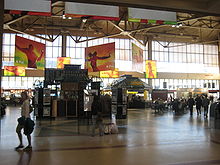- Commuter rail in North America
-
Commuter rail services in the United States, Canada, and Mexico provide common carrier passenger transportation along railway tracks, with scheduled service on fixed routes on a non-reservation basis primarily for short-distance (local) travel between a central business district and adjacent suburbs and regional travel between cities of a conurbation. It does not include rapid transit or light rail service.
Contents
Services
Many, but not all, newer commuter railways offer service during peak times only, and on a round-trip basis. For example, West Coast Express commuter rail runs trains only into Downtown Vancouver during the morning rush hour, and out to the suburbs during the evening rush hour. This mode of operation is in many cases simplified by ending the train with a special passenger carriage (referred to as a cab car), which has an operating cab at one end and can control the locomotive remotely so as to avoid having to turn the train around at each end of its route. Other systems avoid the issue entirely by using bi-directional multiple units.
Many older, established commuter rail services operate their routes on an seven day a week basis, with services running through from early morning to just after mid-night. Some, like the Long Island Rail Road (LIRR), operate key routes on a 24/7 basis. On many of these older systems, patrons use the trains not just for work, or school, but for attending sporting events, concerts, theatre, and the like. Some also provide service to popular week-end getaway spots, and recreation areas.
Most commuter rail services in North America are operated by agencies of government entities or quasi-governmental organizations. Some share the tracks or rights-of-way used by longer-distance passenger services (e.g. Amtrak, Via Rail), freight trains, or other commuter services. The 600 mile-long (960 km long) electrified Northeast Corridor in the United States is shared by commuter trains and Amtrak's Acela Express, regional, and intercity trains.
Commuter rail operators often sell reduced fare multiple-trip tickets (such as a monthly or weekly pass), charge specific station-to-station fares, and have one or two stations in the central business district. Commuter trains are typically connected to metro or bus services both at their destination and along their route to extend the range of accessibility.
Spread
In the United States, inter-city trains are operated by Amtrak over a network that is far less dense than ones found in Europe or Japan. The most heavily used routes with the greatest ridership and schedule frequencies are in the Northeast Megalopolis and the Chicago metropolitan area. About one in every three users of mass transit in the United States and two-thirds of the nation's rail riders live in the New York City metropolitan area.
The two busiest passenger rail stations in the United States are Penn Station and Grand Central Terminal, which are both located in New York City, and which serve three of the four busiest commuter railroads in the United States (the LIRR and New Jersey Transit at Penn Station, and Metro-North Railroad at Grand Central Terminal). The commuter railroads serving the Chicago area are Metra and the South Shore Line.
Commuter rail outside of Washington D.C., New York, Chicago, Philadelphia, Boston, San Francisco, Montreal, and Toronto metropolitan areas is more infrequent and less extensively used relative to networks in European and Japanese cities of comparable size.
Rolling stock
Commuter trains are usually powered by diesel-electric or electric locomotives, or in some cases use self-contained multiple units. Electric power in some instances is transmitted via third rail or overhead wire and catenary. Electric power is often favoured where it is available due to quicker acceleration, lower noise, and fewer air-quality issues. Electric power and even more so multiple-unit trains are, however, much less common than on European railways.
Diesel-electric locomotives based on the EMD F40PH design as well as the MP36PH-3C are popular commuter motive power. Major manufacturers of coaches include Bombardier, Kawasaki and Nippon Sharyo.
List of North American commuter rail operators
Proposed and under construction
There are several commuter rail systems currently in development in Mexico and the United States.
Former
The following systems have ceased operations since the 1970s.
- OnTrack, Syracuse, New York (until 2007)
- Champlain Flyer, Burlington, Vermont (until 2003)
- PATrain, Pittsburgh, PA (until 1989)
- SEMTA, Detroit, Michigan (until 1983)
- Former Erie-Lackawanna, later Conrail, service between Cleveland and Youngstown, Ohio (until 1977)
- Former Milwaukee Road service Milwaukee to Watertown, Wisconsin (until early 1970s)
- Former Missouri Pacific service St. Louis, Missouri to Kirkwood, Missouri (service ended in the 1960s)
- Parkway Limited, Pittsburgh, PA (1981)
-
This list is incomplete; you can help by expanding it.
See also
- Interurban
- List of airport circulators
- List of light-rail transit systems
- List of rapid transit systems
- List of suburban and commuter rail systems
- List of rail transit systems in the United States
References
- ^ a b c d e f g h i j k l m n o p q r s t u v w APTA, [1] Transit Ridership Report.
- ^ Peterson, Matt (June 20, 2011). "A-train railway begins rolling, carrying commuters from Denton to Carrollton". The Dallas Morning News. http://thescoopblog.dallasnews.com/archives/2011/06/a-train-railway-begins-rolling.html. Retrieved June 20, 2011.
- ^ http://www.fsuburbanos.com/secciones/sala_prensa/noticias.php?id=108
- ^ "Info to GO" (PDF). GO Transit. http://www.gotransit.com/public/en/docs/publications/Info%20To%20GO_2011.pdf. Retrieved 24 May 2011.
- ^ "New Jersey Transit facts-at-a-glance". June 2010. http://www.njtransit.com/pdf/FactsAtaGlance.pdf. Retrieved September 21, 2010.
- ^ APTA, [2] Transit Ridership Report.
Categories:- United States regional rail systems
- Passenger rail transport in Canada
- Passenger rail transportation in Mexico
Wikimedia Foundation. 2010.




